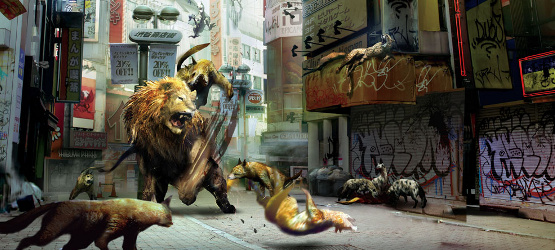In any video game, an allowance needs to be made for things that can’t or don’t usually occur naturally. Were it not so, many games would be quite boring. Tokyo Jungle, however, double dips randomly, picking and choosing which aspects to take from Column A and which to take from Column B in a way that renders it inconsistent and frustrating. Is this supposed to be a simulation or a completely over-the-top arcade game? It feels like a decision was never made on that.
Tokyo Jungle is billed as a type of animal survival game, letting players see what might happen in an apocalyptic world with no humans. In such a game, real survival skills and strategies would be the difference between life and death. But while including these, Tokyo Jungle also drinks from the other cup—the one with no regard for realistic physics or common sense. Describing this game is sometimes best done with stories from within it, and to that end, this review contains several.
On one hand, it’s true that finding places to eat and mate while ducking predators is the very essence of animal survival. On the other hand, a tiny Pomeranian killing a whole flock of sheep and being able to jump over a car is the type of thing you’ll only ever find in a video game. Tokyo Jungle uses both realities interchangeably.
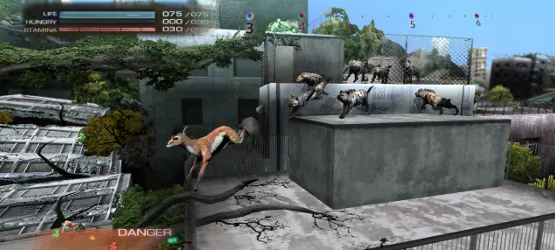
Tokyo Jungle‘s disregard for science doesn’t stop there, though. You’ll have cats hunting deer, rabbits teaming up with lions, and dogs who are unable to find another animal because it went into the fucking weeds. Yeah, we’re talking about a three-by-five patch of weeds in the middle of a paved street, and yet a beagle can’t locate a deer inside there if it’s ducking down. Playing as a pig being chased by a golden retriever, I ducked into those trusty weeds. Despite having seen me run into the small weed patch and despite a golden retriever having a nose like a, well, a fricking golden retriever, I evaded my would-be killer. Animals can even leap high into the air above the weeds, yet most other animals won’t notice. Even when keeping in mind that a video game must take certain liberties, these types of WTF moments are jarring because they don’t make sense within the game’s own universe.
Tokyo Jungle might be the worst-looking game on the PS3. These animals look like they were peeled out of an Atari Jaguar game, and the trees highly resemble things I remember seeing on the original PlayStation…in games that were not known for having the best graphics of the era. The lighting effects range from wretched to unimpressive, and every minute of play will be spent watching a poorly animated creature roam around appearing completely unnatural. When running around with a group of beagles, the lead dog maintained a shadow across his face, while the second dog—three feet behind the first—had his whole front side lit up by sunshine. What is that? Who made that? Who looked at that and thought it was good enough for someone to spend money on? The game is full of things like that—shadows coming from the wrong direction, graphic overlap, invisible walls, and basically any other visual blemish you can imagine. It’s even worse in Story Mode, when the camera zooms in on certain animals during event scenes, showing you just how horrible they look. Even the textures on the pavement don’t look right. How do you mess up pavement? Ask Sony.
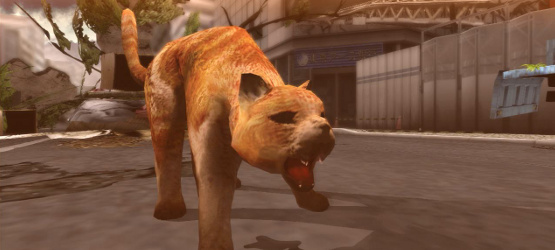
This is frustrating because Tokyo Jungle does have a lot going for it. Playing Survival Mode again and again will allow the animals to get more and more future generations built up, with improving stats and eventually, new breeds. Tons of new pieces of equipment and other bonuses are waiting to be unlocked, adding some lasting value. The game packs 50 animals to eventually control, though only the Pomeranian and white-tailed deer are selectable at the beginning. A few runs through survival mode will net one the points necessary to unlock the house cat and other creatures of the animal kingdom.
This is a game whose setting delivers so many possibilities—taking place in one of the biggest and most famous cities in the world—yet players will spend most of their time seeing the same handful of places over and over again in Survival Mode. It can be very fun continually scouring the city, finding food, checking the map, strategically planning one’s route, picking up items, and trying to scrape by. At the same time, the way the game feels barely resembles what one might envision with the description.
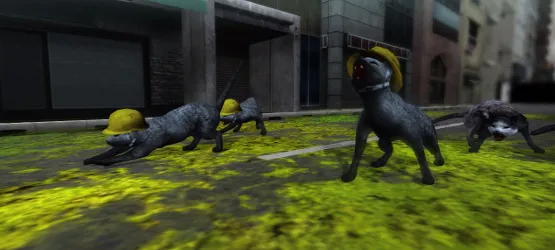
Where Tokyo Jungle does truly achieve something is with its concept and creativity. Innovation is always welcome, and this idea is one that absolutely should have been tried in video game form. It’s so unique that even despite how horribly put together it is, it’s something you’ll almost certainly want to show everyone if there’s a party at your house. A large group watching one or two people play this game is a situation prone to hilarious conversation and big laughs. And perhaps this was Sony Japan Studio’s intention all along—creating a game that a bunch of people could watch and laugh at. In that regard, the game is a huge success, though part of the laughter will be because of just how bad the game looks. The North American price of $14.99 might be worth it to try a game so experimental and funny, but I pity the poor Japanese fans, who had to pay full retail price for this.
The problem is that it’s so innovative and different with its concept, yet plays like an older game with all of its old-time hangups and technical oversights. One time, I was playing as a deer and had gotten into some trouble with a herd of goats. Outnumbered, I ran away, fleeing down a series of streets and then ducking into an alley. At the end of the lane, as my deer came back onto a different street, an angry goat rammed right into me taking revenge for his fallen species member across town. Here’s the thing…how the hell did he know there was a deer coming down the alley, and that he should clothesline it as it rounded the corner? Did he log onto the goat revenge website and see a picture of a deer and be like “After that troll at the bridge, this sucka’s going down!”? Did he get radio communication from Jim Breuer telling him what ha-a-a-ad ha-a-a-appened? Obvious video game-isms like that are all over the place in Tokyo Jungle. With a concept this good, the whole gaming world should still keep its eyes open for a sequel or spinoff; if done with a little more care, this might have been a solid game.
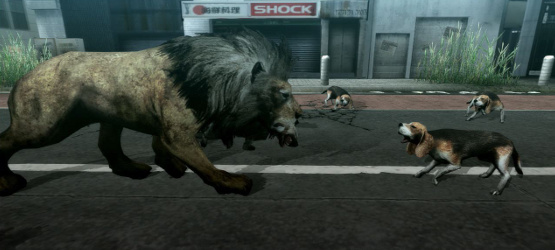
Multiplayer doubles the problems as much as it does the on-screen characters. While the increased challenge can be welcome, the game’s faults and glitches are blown up and made worse. Running around with two characters of the same class (herbivore or carnivore) will essentially halve the food supply while using one of each class will often times damn one side or the other, letting one of the two players die an untimely death while the other player boringly carries on. Whatever animal types you choose can’t be eaten, so for example, if your team is a pig and a lion, the lion won’t be able to eat a pig. What is this, a Disney movie? The game’s rule, of course, is that a character can’t consume its own species, but it applies this to multiplayer like it’s a Milo and Otis situation. Imagine your dismay when the aforementioned lion you chose finds itself in a survival run where the primary food target is pigs, yet you can’t eat them because your teammate is a pig. It’s not usually the intention of multiplayer to have one of the two controllers being set down so long before the other. Obviously, Mother Nature can be cruel, too, and scenarios of her brutality are a nice inclusion, but these are not ones brought on by nature, they’re brought on by a video game having been developed by people who lack foresight.
With two players, it will often be the case that one drags the screen away from the other, as the two animals may need to divide and conquer. With visuals this horrendous, however, one player will often find himself unable to tell what’s going on. Despite there being a 1P or 2P arrow above the two player-controlled animals, it’s all too easy to lost track of who’s who and what’s what in some situations. Even simple navigation will get tedious with two players. “I’m excited to play Tokyo Jungle multiplayer again!” my wife said on our second or third day of having the game. “Me too,” I agreed. By the end of a Survival run or two, we concluded that our first playthroughs were more fun because of how new and innovative everything was. As we got more used to what Tokyo Jungle was all about, most of its humor subsided, and its flaws were pushed to the foreground.
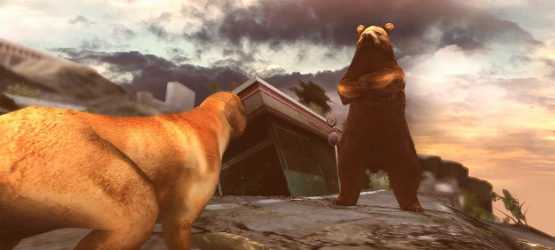
It soon becomes obvious that the game is played extremely similarly no matter what animal the player takes, and this epiphany can kill one’s ambition. Outside of the stenciled herbivore and carnivore methods of play, very little changes from animal to animal. The only motivations for going through Survival Mode again and again are unlocking story segments and unlocking new animals; the two problems with this are that doing so becomes tedious, and the rewards boil down to more of that same tedium. “Good thing I unlocked the goat because it…huh…wow, it plays exactly like the gazelle, and the deer, and the pig, and most of the other plant eaters….” Bigger animals do handle a little bit differently because of their size and power, but the gameplay remains almost identical: eat, eat, eat, mark territory, eat, mark territory, gotta find a place to eat, more eating, mate to get a new character with stat changes too small to notice…and then eat, eat, eat, and so on.
Tokyo Jungle is in some small ways a success, and in others, a failure. It does deserve a ton of credit for being a fresh type of game, so unique in its concept. This game is also something to consider if you have a lot of gamer gatherings at your place and want something you and your friends can laugh at, as it produces hilarious stories and highlight-reel moments by the dozen. But fun quickly fades when trying to actually go through the game, with the experience being dragged down by the crazy inconsistencies of its own world, sloppy multiplayer, disgraceful graphics, annoying music, an overdose of repetition, and too many smaller glitches to count.
-
Unique concept, really in a class by itself.
-
Hilarious for a big group to watch.
-
Also hilarious because of how bad it is.
-
Could be the start of something good. Maybe.
-
Perhaps the worst visuals of the generation.
-
Inconsistency within its own universe.
-
Almost all animals still fall under one of two styles of play.
-
Repetitive repetition.
-
Dysfunctional multiplayer.
-
Ability to go through Story Mode is way too tied to Survival Mode.
-
Annoying soundtrack with extremely short song list.
